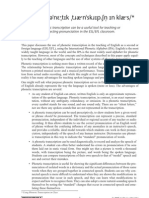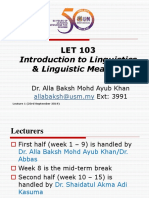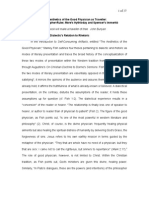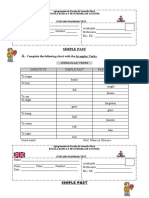LING 101 Fall 2015 Midterm Study Sheet
LING 101 Fall 2015 Midterm Study Sheet
Uploaded by
johanna_341529511Copyright:
Available Formats
LING 101 Fall 2015 Midterm Study Sheet
LING 101 Fall 2015 Midterm Study Sheet
Uploaded by
johanna_341529511Original Description:
Copyright
Available Formats
Share this document
Did you find this document useful?
Is this content inappropriate?
Copyright:
Available Formats
LING 101 Fall 2015 Midterm Study Sheet
LING 101 Fall 2015 Midterm Study Sheet
Uploaded by
johanna_341529511Copyright:
Available Formats
Ling 101/Anth 110 (Fall 2015)
Midterm Review Sheet
Exam format
The exam will be posted online. The due date for submitting the exam is Sunday 11th. The exam
will look much like the quizzes; multiple-choice and some short answer. The midterm is worth
30% of your total course grade. To study for the exam Review the questions that were on the
quizzes. These will provide a good model for the types of problems that will be presented on the
exam (although you will see a few types of questions that were not on a quiz). You are expected
to be familiar with all content presented on this review sheet. Review the book chapters and
posted slides carefully. For topics you maybe did not fully understand take advantage of the
tutors at CAPS (Fazal) or send your problems and questions to me by email.
EXAM CONTETNS
What is language? Linguistics?
Prescriptivism vs. Descriptivism
Hocketts Design Features of language
1. Mode of Communication
2. Pragmatic Function
3. Displacement
4. Arbitrariness
5. Productivity
6. Cultural Transmission
7. Duality
Phonetics
International Phonetic Alphabet (IPA) Keep the chart next to you at the exam time.
Consonants; be able to describe and identify:
o Voicing
o Place of articulation
o Manner of articulation
Vowels; be able to describe and identify:
o Tongue Height
o Tongue Advancement
o Rounding
o Tenseness
- Be able to give features for an IPA symbol
Exp: [p] => voiceless, bilabial, stop
- Be able to give the IPA symbol for provided features
Exp: voiceless, bilabial, stop => [p]
Transcription (be able to identify the correct multiple choice answer)
IPA Orthography
o [kt] cat
Orthography IPA
o peach [pi]
Phonology
Identifying minimal pairs
Phonemes vs. allophones
Natural classes
Phonological processes (be able to identify the type of phonological process that is responsible
for the appearance of some sound or sequence of sounds, if asked)
Assimilation
Nasalization
Elision
Morphology
Morpheme types
Free vs. Bound
Lexical vs. Functional
Inflectional vs. Derivational
o You might be asked to provide the morpheme breaks of a word in English or another
language unfamiliar to you and then to identify the morpheme type(s).
Allomorphs
Morphological analysis of a small data set
Deciphering morphemes and their meanings
Deciphering morpheme types
Syntax
Identifying syntactic categories (nouns, verbs, prepositions, adjectives, determiners, etc.)
Identifying syntactic phrases (e.g., NP, VP, PP, etc)
o (Phrase Structure Rules will be provided for you on the exam. You just need to
understand how to read them.)
Understanding how to read and produce syntactic tree representations in general
Understanding how to identify and interpret structural ambiguity
2
You might also like
- Caribbean and Standard EnglishDocument4 pagesCaribbean and Standard EnglishHassan Basarally50% (2)
- Consider The Distribution ofDocument6 pagesConsider The Distribution ofIgnacio Muñoz Çerdâ50% (2)
- All About IELTS: Step by Step Practical Guide to Crack IELTSFrom EverandAll About IELTS: Step by Step Practical Guide to Crack IELTSRating: 5 out of 5 stars5/5 (3)
- Catch Come Fallen Went Handed Look Put TakeDocument2 pagesCatch Come Fallen Went Handed Look Put TakeЗорица Димовска67% (6)
- Haegeman's ExercisesDocument35 pagesHaegeman's Exercisesahmedismail570No ratings yet
- Jamaican English or Jamaican Standard English Is A Dialect of English Encompassing in A Unique WayDocument7 pagesJamaican English or Jamaican Standard English Is A Dialect of English Encompassing in A Unique WayOkolo AllenNo ratings yet
- English Irregular Verbs With IPA and FrenchDocument5 pagesEnglish Irregular Verbs With IPA and FrenchcristinadciNo ratings yet
- Fakultas Keguruan Dan Ilmu Pendidikan: Program Studi Pendidikan Bahasa InggrisDocument2 pagesFakultas Keguruan Dan Ilmu Pendidikan: Program Studi Pendidikan Bahasa InggrisBella LestariNo ratings yet
- Solutions 2 11Document3 pagesSolutions 2 11Jacob WilliamsNo ratings yet
- Teaching Summary Writing Through Scaffolding 2 2 PDFDocument4 pagesTeaching Summary Writing Through Scaffolding 2 2 PDFAstrid HernandezNo ratings yet
- 1 What Is Syntax?: 1.1 Some Concepts and MisconceptionsDocument5 pages1 What Is Syntax?: 1.1 Some Concepts and MisconceptionsAjlalPsychONo ratings yet
- Phonetics PhonologyDocument22 pagesPhonetics PhonologyCourtneyJentschNo ratings yet
- Answer ELS Answer in Unit 2 (Written Activity)Document14 pagesAnswer ELS Answer in Unit 2 (Written Activity)Ana Amistad100% (3)
- Introduction To Phonetic ScienceDocument49 pagesIntroduction To Phonetic ScienceMonMaNo ratings yet
- Lecture 1Document5 pagesLecture 1Nurmunirah masliNo ratings yet
- General English Mid Course Feedback FormDocument2 pagesGeneral English Mid Course Feedback FormFAdreamNo ratings yet
- Introduction To Spoken EnglishDocument8 pagesIntroduction To Spoken Englishabhranilghosh1No ratings yet
- 5 Morphology Part1Document29 pages5 Morphology Part1ase046083No ratings yet
- Phonics Scope and SequenceDocument8 pagesPhonics Scope and Sequenceapi-198027280No ratings yet
- NLP Lect 2 Words and MorphologyDocument52 pagesNLP Lect 2 Words and Morphology21051918No ratings yet
- Oral Presentation - Sec 5Document3 pagesOral Presentation - Sec 5api-306133503No ratings yet
- Teaching The Phonemic ChartDocument4 pagesTeaching The Phonemic ChartJonathan NealNo ratings yet
- Booklet 1Document45 pagesBooklet 1Nora Beatriz DiazNo ratings yet
- English Practical Course: 1st Year, LMA, 1st Semester - As. Dr. Monica ManolachiDocument2 pagesEnglish Practical Course: 1st Year, LMA, 1st Semester - As. Dr. Monica ManolachiLuizaMarinNo ratings yet
- Unit 2Document17 pagesUnit 2SAMANTHA MAY PABUSTANNo ratings yet
- Components of Language ReviewDocument32 pagesComponents of Language Reviewqurrataindah 04No ratings yet
- PG Ca L1 PDFDocument27 pagesPG Ca L1 PDFtrangcreamy9497No ratings yet
- Phonetics and Phonology DissertationDocument4 pagesPhonetics and Phonology DissertationPaperWritingServicesBestUK100% (1)
- LIN101Document7 pagesLIN101Nikita DavidsonNo ratings yet
- Syllabus For Introduction To Linguistics FINALDocument5 pagesSyllabus For Introduction To Linguistics FINALJoon Rin100% (2)
- IELTS MaterialsDocument162 pagesIELTS MaterialsOzel OlafNo ratings yet
- Instrumental Techniques For Linguistic Phonetic Fieldwork - The Handbook of Phonetic Sciences - Blackwell Reference OnlineDocument22 pagesInstrumental Techniques For Linguistic Phonetic Fieldwork - The Handbook of Phonetic Sciences - Blackwell Reference OnlineHAKAN ÖZTEMÜRNo ratings yet
- Example Items in Measuring Vocabulary, Listening, Speaking Skills and Assessing SpeakingDocument9 pagesExample Items in Measuring Vocabulary, Listening, Speaking Skills and Assessing SpeakingJen AndaganNo ratings yet
- Introduction To ToeflDocument2 pagesIntroduction To ToeflIrvink de NaldiNo ratings yet
- Phonetics - Using Phonetic Transcription in ClassDocument12 pagesPhonetics - Using Phonetic Transcription in ClassmdkaifahmedNo ratings yet
- PronunciationDocument11 pagesPronunciationSigitaNo ratings yet
- Psycholinguisctics: Budapest Semester in Cognitive Science Cognitive Psychology Day 2Document90 pagesPsycholinguisctics: Budapest Semester in Cognitive Science Cognitive Psychology Day 2Jenebeth VelascoNo ratings yet
- Phonetics NotesDocument9 pagesPhonetics Notesguillaumelabbe6No ratings yet
- Indian Institute of Technology KanpurDocument42 pagesIndian Institute of Technology KanpurAvi AlokNo ratings yet
- LRT_nameDocument13 pagesLRT_nameandressagbiancoNo ratings yet
- 5th Grade - Speaking Rubric Unit 2Document5 pages5th Grade - Speaking Rubric Unit 2natty3110No ratings yet
- Meeting 1 - Introduction To Linguistics For TeachersDocument63 pagesMeeting 1 - Introduction To Linguistics For TeachersSommerledNo ratings yet
- Modulo Clases Practicas. 2020 PDFDocument60 pagesModulo Clases Practicas. 2020 PDFLynn uwuNo ratings yet
- Phonemic Awareness VS PhonicsDocument35 pagesPhonemic Awareness VS PhonicsJaylie PeñaNo ratings yet
- Two SubsysDocument28 pagesTwo SubsysHijab BatoolNo ratings yet
- Symbol Grounding and The Origin of LanguageDocument35 pagesSymbol Grounding and The Origin of LanguageGuoh JiangNo ratings yet
- Oral Assessment CriteriaDocument1 pageOral Assessment CriteriaIsolda Junca CañasNo ratings yet
- Cont PhonDocument49 pagesCont Phonİpek SARIKAYANo ratings yet
- PhonologyDocument36 pagesPhonologylearn English by yourself InstagramNo ratings yet
- Thesis Phonetic SpellingDocument6 pagesThesis Phonetic Spellingfbyhhh5r100% (2)
- Introduction To Linguistics & Linguistic Meaning: Dr. Alla Baksh Mohd Ayub Khan Ext: 3991Document43 pagesIntroduction To Linguistics & Linguistic Meaning: Dr. Alla Baksh Mohd Ayub Khan Ext: 3991Hanifu ImuranNo ratings yet
- Phonology_Theory and AnalysisDocument23 pagesPhonology_Theory and Analysischidiogo.victoria2015No ratings yet
- Phonemic Problems in Language AcquisitionDocument13 pagesPhonemic Problems in Language Acquisitionperlishell74No ratings yet
- Final - Contrastive AnalysisDocument11 pagesFinal - Contrastive AnalysisHuysymNo ratings yet
- Meeting 2 Ling in ELT (2024)Document36 pagesMeeting 2 Ling in ELT (2024)alifah syifa rahmadillahNo ratings yet
- Morphological Typology - Spring 2016 - Ling 100 Guest LectureDocument34 pagesMorphological Typology - Spring 2016 - Ling 100 Guest LecturePradip MapuNo ratings yet
- Unit 5 - PhonologyDocument9 pagesUnit 5 - PhonologyTahaNo ratings yet
- ENG-113 Introduction To Linguistics-IDocument4 pagesENG-113 Introduction To Linguistics-IAbdul Waheed100% (1)
- Mindset Compressed 0001Document31 pagesMindset Compressed 0001Tạ TrangNo ratings yet
- Module Intro and Oral Delivery Session 2Document35 pagesModule Intro and Oral Delivery Session 2djc64ykpx8No ratings yet
- ENG507 SHORT HANDOUTS MIDTERM Compiled by Sir Zahid-1Document23 pagesENG507 SHORT HANDOUTS MIDTERM Compiled by Sir Zahid-1rahatkhurshid471No ratings yet
- 004 Evaluation-Against-a-StandardDocument3 pages004 Evaluation-Against-a-StandardChristopher CoxNo ratings yet
- Critical Introduction To PhoneticsDocument255 pagesCritical Introduction To Phoneticsbizcj19685100% (7)
- TTU Degree PlanDocument10 pagesTTU Degree Planjohanna_341529511No ratings yet
- Painted Poetry Colour in Baudelaires Art Criticism Modern French IdentitiesDocument264 pagesPainted Poetry Colour in Baudelaires Art Criticism Modern French Identitiesjohanna_341529511No ratings yet
- Logos Biblical Greek KeyboardDocument8 pagesLogos Biblical Greek Keyboardjohanna_341529511No ratings yet
- SLIDES - Syntax (Trees & Phrases)Document46 pagesSLIDES - Syntax (Trees & Phrases)johanna_341529511No ratings yet
- Luther and Prot FinalDocument56 pagesLuther and Prot Finaljohanna_341529511No ratings yet
- Syllabus Lat 16 Age Augustus Livy CourseDocument5 pagesSyllabus Lat 16 Age Augustus Livy Coursejohanna_341529511No ratings yet
- Catalus 2Document11 pagesCatalus 2johanna_341529511No ratings yet
- Aesthetics of The Good PhysicianDocument27 pagesAesthetics of The Good Physicianjohanna_341529511No ratings yet
- Tudors 1485-1603Document1 pageTudors 1485-1603johanna_341529511No ratings yet
- Traditional Grammar Terminology LatinDocument21 pagesTraditional Grammar Terminology Latinjohanna_341529511No ratings yet
- Poole MetaphorDocument48 pagesPoole Metaphorjohanna_341529511No ratings yet
- ToscaStudyGuide 000Document42 pagesToscaStudyGuide 000johanna_341529511100% (3)
- Baroque Sculpture - Berninis FountainsDocument71 pagesBaroque Sculpture - Berninis Fountainsjohanna_341529511No ratings yet
- Materi Simple Past TenseDocument6 pagesMateri Simple Past TenseFIKANo ratings yet
- Morphology: The Study of The Structure of Words and Types of Their Formation - What Is A Word ?Document17 pagesMorphology: The Study of The Structure of Words and Types of Their Formation - What Is A Word ?seba alrogiNo ratings yet
- W. 3 8th English - Past SimpleDocument4 pagesW. 3 8th English - Past SimpleArturoNo ratings yet
- Suggestions and Advice: 271 Key Language Making SuggestionsDocument2 pagesSuggestions and Advice: 271 Key Language Making SuggestionsYessica RosasNo ratings yet
- Reported Speech BachilleratDocument2 pagesReported Speech BachilleratlorenaNo ratings yet
- Schoolhouse Rock - Grammar Rock Unpack Your AdjectivesDocument2 pagesSchoolhouse Rock - Grammar Rock Unpack Your AdjectivesLan Pak YaNo ratings yet
- Toeic Speaking Wk2Document6 pagesToeic Speaking Wk2ChuoiEmNo ratings yet
- Gerund and To InfinitiveDocument15 pagesGerund and To InfinitiveDina YandiniNo ratings yet
- Lesson 5 - 18 - 2 Comparative and SuperlativeDocument4 pagesLesson 5 - 18 - 2 Comparative and SuperlativeChristian AguilarNo ratings yet
- Grammar f2Document6 pagesGrammar f2Zurina Razali100% (1)
- Discourse Analysis: Monday, 21 September 2020Document7 pagesDiscourse Analysis: Monday, 21 September 2020EklesiaUmbohNo ratings yet
- Semana 9Document46 pagesSemana 9Angel Paul LaraNo ratings yet
- Simple Past: - Complete The Following Chart With The Irregular VerbsDocument2 pagesSimple Past: - Complete The Following Chart With The Irregular VerbsNatércia OliveiraNo ratings yet
- Taller InglésDocument4 pagesTaller InglésMonica OramasNo ratings yet
- Hers, It, Its, They, Them, Their, Theirs.: Table of Personal PronounsDocument5 pagesHers, It, Its, They, Them, Their, Theirs.: Table of Personal PronounsWolfo ChicoNo ratings yet
- Irregular Verbs ChartDocument5 pagesIrregular Verbs ChartLeo YantornoNo ratings yet
- English/Filipino: Independent Study Plan and Resources For Seventh GradeDocument15 pagesEnglish/Filipino: Independent Study Plan and Resources For Seventh Gradedarryl franciscoNo ratings yet
- TA12 - Unit 4Document39 pagesTA12 - Unit 4HuyenNo ratings yet
- The Syntax of Temporal RelationsDocument8 pagesThe Syntax of Temporal RelationsHéctor HernándezNo ratings yet
- English Language Jhs 1-3Document115 pagesEnglish Language Jhs 1-3Fanny Amalia100% (1)
- Summative Test - ADocument7 pagesSummative Test - ANathaniel ValenciaNo ratings yet
- Subject Verb Agreement ExerciseDocument3 pagesSubject Verb Agreement ExerciseSipra PaulNo ratings yet
- INTERCHANGE 1 - QUIZ UNITS 9 & 10 - Revisión Del IntentoDocument5 pagesINTERCHANGE 1 - QUIZ UNITS 9 & 10 - Revisión Del Intentoest.ghumberto100% (1)
- Arabic Verbal Nouns As Phonological HeadDocument19 pagesArabic Verbal Nouns As Phonological Headabdelkader el-khaouaNo ratings yet
- Self Learning Kit These Are Those AreDocument11 pagesSelf Learning Kit These Are Those Areelyssa marie pradoNo ratings yet
- Scott Waited - (Patient) For His Girlfriend To FinishDocument3 pagesScott Waited - (Patient) For His Girlfriend To Finishmaried eliana marinNo ratings yet
- RPT Tahun 3 31Document15 pagesRPT Tahun 3 31wajy05No ratings yet






































































































